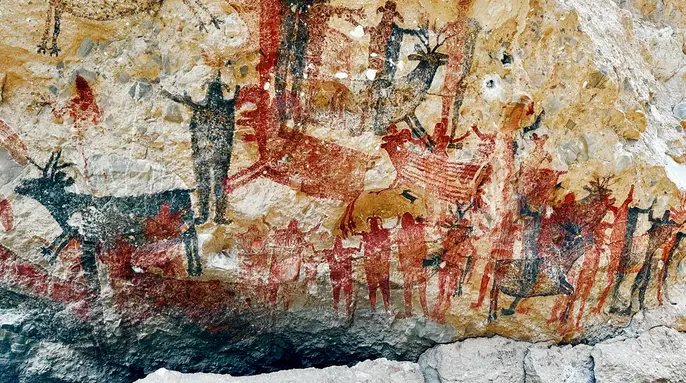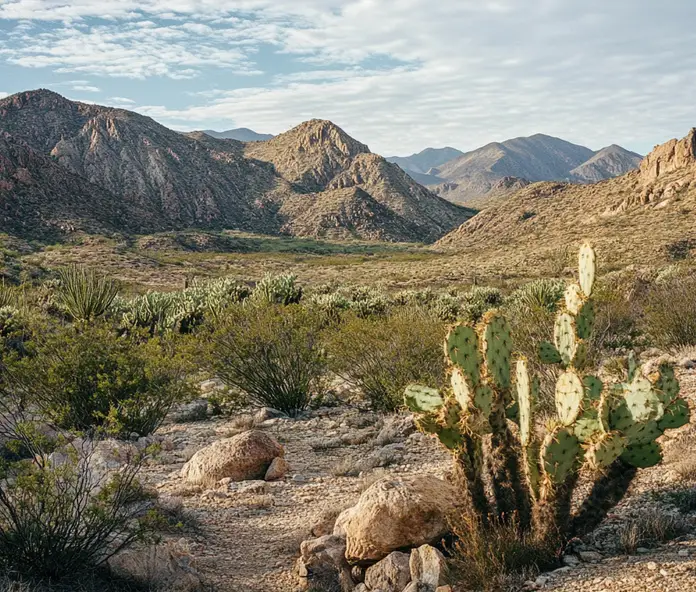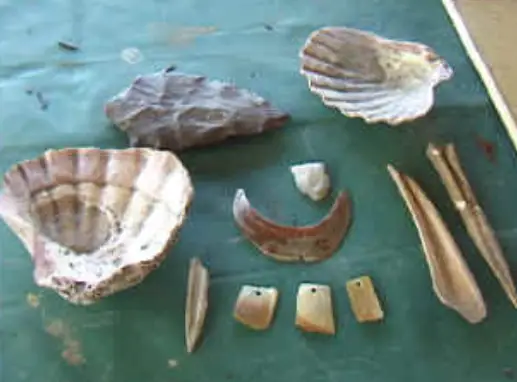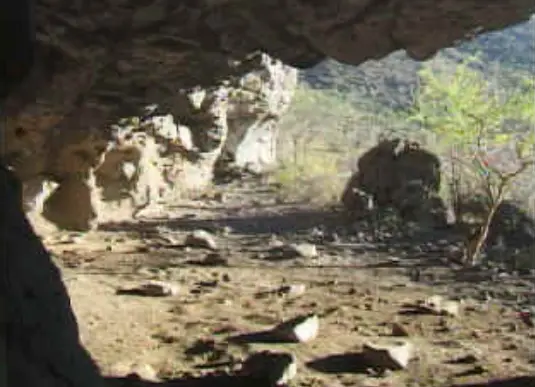Podcast: Play in new window | Download
Subscribe: Apple Podcasts | RSS
 The Baja California Peninsula, a rugged spine of desert and mountain stretching between the Pacific Ocean and the Gulf of California, is a landscape that seems to guard its secrets. While its vibrant rock art has drawn global attention and has even been talked about here on Mexico Unexplained, the peninsula harbors a broader, less celebrated archaeological legacy. Beyond the painted caves and petroglyphs lie the subtle remains of a vanished people: shell middens, campsites, burial caves, hunting blinds, and processing sites. These remnants, often overlooked, belong to indigenous groups such as the Cochimí, Pericú, and others whose cultures flourished in this arid frontier for millennia before fading under the weight of contact by outsiders. The scarcity of knowledge about these peoples, coupled with the inaccessibility of their archaeological sites due to protective restrictions and remote terrain, cloaks these ruins in an aura of mystery. In this episode we will explore the non-rock art archaeology of Baja California, emphasizing the types of sites, their cultural significance, and the challenges of studying a past that remains tantalizingly out of reach.
The Baja California Peninsula, a rugged spine of desert and mountain stretching between the Pacific Ocean and the Gulf of California, is a landscape that seems to guard its secrets. While its vibrant rock art has drawn global attention and has even been talked about here on Mexico Unexplained, the peninsula harbors a broader, less celebrated archaeological legacy. Beyond the painted caves and petroglyphs lie the subtle remains of a vanished people: shell middens, campsites, burial caves, hunting blinds, and processing sites. These remnants, often overlooked, belong to indigenous groups such as the Cochimí, Pericú, and others whose cultures flourished in this arid frontier for millennia before fading under the weight of contact by outsiders. The scarcity of knowledge about these peoples, coupled with the inaccessibility of their archaeological sites due to protective restrictions and remote terrain, cloaks these ruins in an aura of mystery. In this episode we will explore the non-rock art archaeology of Baja California, emphasizing the types of sites, their cultural significance, and the challenges of studying a past that remains tantalizingly out of reach.
The indigenous inhabitants of Baja California were primarily hunter-gatherers or semi-nomadic groups, distinct from the urban civilizations of Mesoamerica. Archaeological and ethnohistorical evidence suggests they included the Cochimí in the central and northern peninsula, the Pericú in the south, and smaller groups like the Guaycura. There are other groups on the list that vanished before European contact and remain nameless. These peoples adapted to one of North America’s harshest environments, relying on marine resources, desert plants, and game. Their material culture, shaped by mobility and scarcity, left behind no grand pyramids, elaborate sculptures or stone cities but rather fleeting traces: scatters of tools, heaps of shells, and faint outlines of camps. By the time Spanish missionaries arrived in the late 17th century, these groups were already in decline, decimated by disease and cultural disruption. Today, their descendants are few, and their languages and traditions are largely lost, leaving archaeology as the primary window into their world.
 The scarcity of written records and the limited ethnographic data from early European accounts deepen the enigma. Who were these people? What beliefs animated their lives? How did they thrive in a landscape that tests human endurance? The answers lie in the archaeological record, but the sites themselves are scattered, fragile, and often inaccessible, guarded by both natural barriers and human restrictions.
The scarcity of written records and the limited ethnographic data from early European accounts deepen the enigma. Who were these people? What beliefs animated their lives? How did they thrive in a landscape that tests human endurance? The answers lie in the archaeological record, but the sites themselves are scattered, fragile, and often inaccessible, guarded by both natural barriers and human restrictions.
Unlike the monumental ruins of Chichén Itzá or Teotihuacán, Baja’s non-rock art sites are understated, blending into the desert’s rugged contours. They reflect a lifeway centered on mobility, resourcefulness, and adaptation. The following sections detail the primary types of sites, their significance, and specific examples, drawing on archaeological studies to illuminate their context.
Shell middens—accumulations of shellfish remains mixed with bones, tools, and other debris—are among the most common archaeological features along Baja’s coasts. These sites, found on both the Pacific and Gulf shores, testify to the importance of marine resources for groups like those of the La Jolla complex dating back 8,000 to 3,000 years ago. Middens vary in size from small scatters to massive deposits several meters deep, some dating back to the end of the Ice Age around 10,000 years ago. They contain shells of mussels, clams, and oysters, alongside fish bones, stone tools, and occasionally human burials, suggesting long-term or seasonal occupation.
The significance of middens lies in their ability to reveal diet, trade, and environmental adaptation. For instance, the presence of non-local shell species in some middens hints at trade networks or seasonal migrations. Their preservation in Baja’s arid climate makes them valuable for reconstructing ancient lifeways. A notable example is found near Bahía de los Ángeles on the Gulf coast, where middens associated with the Comondú complex – dating from 1,000 years ago to contact with Europeans – contain tools and ceramics, indicating a late prehistoric shift toward more complex  material culture. Another example is the coastal middens near El Rosario in southern Baja California, recently surveyed by Mexico’s National Institute of Anthropology and History – INAH – which date to approximately 3,000 years ago and include evidence of fishing and shellfish processing.
material culture. Another example is the coastal middens near El Rosario in southern Baja California, recently surveyed by Mexico’s National Institute of Anthropology and History – INAH – which date to approximately 3,000 years ago and include evidence of fishing and shellfish processing.
Campsites, ranging from temporary shelters to semi-permanent villages, are scattered across Baja’s intermountain valleys and coastal plains. These sites, associated with complexes like the San Dieguito dating from 10,000 to 7,000 years ago and Comondú, contain hearths and stone tools such as bifaces, scrapers, and crescents. Occasionally these campsites will include structural remains like windbreaks or cleared areas. They reflect the mobility of Baja’s peoples, who moved between resource-rich zones to exploit seasonal availability of food and water.
These sites are crucial for understanding technological and ecological adaptations. For example, the presence of crescents—distinctive, crescent-shaped stone tools—links Baja’s early inhabitants to broader North American hunting traditions. A documented campsite in the Sierra de San Francisco, near the famous rock art caves, includes hearths and lithic scatters, suggesting temporary occupation by groups who also created the murals. Another example is a Comondú-era site near the town of Mulegé, where archaeologists have identified tool-making areas and possible dwelling structures, indicating a more settled lifeway in the late prehistoric period.
 Burial caves, often located in remote canyons, are among Baja’s most evocative sites. The peninsula’s dry climate has preserved organic materials, including mummified human remains, textiles, and grave goods like shells, tools, and beads. These sites offer glimpses into spiritual beliefs and social organization, though their interpretation is complicated by the lack of contextual data. Unlike Mesoamerican burials with clear iconography and sometimes written text, Baja’s burial caves are enigmatic, their meanings obscured by time.
Burial caves, often located in remote canyons, are among Baja’s most evocative sites. The peninsula’s dry climate has preserved organic materials, including mummified human remains, textiles, and grave goods like shells, tools, and beads. These sites offer glimpses into spiritual beliefs and social organization, though their interpretation is complicated by the lack of contextual data. Unlike Mesoamerican burials with clear iconography and sometimes written text, Baja’s burial caves are enigmatic, their meanings obscured by time.
A notable example is a cave in the central peninsula, documented but not publicly disclosed by INAH, containing mummified remains and offerings. Such sites are rare and highly sensitive, often considered sacred by indigenous descendants. Their study raises ethical questions about disturbance and repatriation, adding to their mystique.
Hunting blinds are low stone structures used to ambush game like bighorn sheep. These are found in Baja’s mountainous regions, particularly the Sierra de Guadalupe. These sites, often paired with rock quarries where tools were crafted, highlight the technological ingenuity of Baja’s peoples. Quarries, rich in obsidian, chert, and other tool-making materials, contain stone flakes and partially finished tools, revealing ancient manufacturing processes.
An example is a quarry site in the Sierra de San Francisco, where archaeologists have documented obsidian tool production alongside hunting blinds. These sites underscore the intimate knowledge of the landscape required to sustain a hunting-based economy in a resource-scarce environment.
Bedrock mortars or metates are depressions ground into rock surfaces for processing seeds, nuts, or other foods. These are found near campsites and rock shelters. Associated primarily with the Comondú complex, these features indicate a growing reliance on plant resources in late prehistory. They are often accompanied by grinding stones and other processing tools, suggesting communal food preparation.
A well-documented example is at Cueva Pintada, a rock art site that also contains mortars and lithic scatters. These mortars, carved into granite outcrops, hint at seasonal gatherings where groups processed desert plants like agave or mesquite. Their presence challenges assumptions of Baja’s peoples as solely marine-focused, revealing a more diverse subsistence strategy.
 The study and visitation of Baja’s archaeological sites are hindered by significant barriers, both natural and institutional. The peninsula’s terrain—rugged mountains, waterless deserts, and remote coastlines—makes many sites difficult to reach. Accessing them often requires four-wheel-drive vehicles, mule treks, or long hikes, limiting exploration to well-equipped researchers or guided expeditions. For example, the Sierra de San Francisco, home to both rock art and campsites, is accessible only via dirt tracks and guided tours, with visitors needing permits and local escorts.
The study and visitation of Baja’s archaeological sites are hindered by significant barriers, both natural and institutional. The peninsula’s terrain—rugged mountains, waterless deserts, and remote coastlines—makes many sites difficult to reach. Accessing them often requires four-wheel-drive vehicles, mule treks, or long hikes, limiting exploration to well-equipped researchers or guided expeditions. For example, the Sierra de San Francisco, home to both rock art and campsites, is accessible only via dirt tracks and guided tours, with visitors needing permits and local escorts.
Institutional restrictions further complicate access. INAH, Mexico’s authority on archaeological heritage based in Mexico City, tightly regulates site visitation to prevent looting and vandalism. Many sites, particularly burial caves and middens, are on private land or within protected areas like biosphere reserves, requiring special permits that are rarely granted to the public. For instance, the El Rosario sites surveyed by INAH are not open to tourists, and their precise locations are kept secret to protect them. Even researchers face bureaucratic hurdles, with cumbersome paperwork and permits which are often delayed or restricted to specific projects. These measures, while essential for preservation, shroud Baja’s archaeology in secrecy, as few beyond a handful of specialists ever witness the sites firsthand.
The lack of public access feeds the mystery surrounding these ruins and some fringe researchers wonder if there is something that government officials wish to hide in Baja. Unlike the heavily touristed Mayan sites of the Yucatán, the peninsula’s archaeological zones are not mapped on travel brochures or promoted as destinations. Their obscurity is compounded by the limited publication of findings, as INAH prioritizes site protection over dissemination of information. As a result, even basic information—such as the total number of sites or their precise cultural affiliations—remains elusive, leaving the public and many scholars in the dark.
The archaeological record of Baja California is a patchwork of clues, offering tantalizing but incomplete insights into its ancient inhabitants. Several factors contribute to the enduring mystery of these sites:
One is cultural enigma: The Cochimí and other groups left no written records, and their oral traditions were largely lost during the mission period. Ethnohistorical accounts by Jesuit missionaries, such as those of Miguel Venegas, provide fragmented glimpses but are biased and incomplete. Archaeological data, while rich, lacks the narrative clarity of Mesoamerican iconography and written text, leaving questions about beliefs, social structure, and intergroup relations unanswered.
Another is chronological uncertainty: Dating Baja’s sites is challenging due to the scarcity of organic materials for radiocarbon analysis and the reuse of sites over millennia. For example, claims of pre-Clovis occupation (before 13,000 years ago) based on early San Dieguito sites remain controversial, as do the precise timelines of complexes like La Jolla and Comondú. This uncertainty fuels speculation about the peninsula’s role in early human migration.
Yet another factor contributing to the mystery is the disappearance of the people: The rapid decline of Baja’s indigenous populations after Spanish contact—due to disease, forced labor, and cultural assimilation—left a void in cultural continuity. Unlike some Mesoamerican groups with living descendants who maintain traditional knowledge, Baja’s peoples are largely a historical mystery, their stories preserved only in the fragile traces of their ruins.
Also, the research on Baja’s sites is very, very limited: Compared to central Mexico, Baja’s archaeology has received less attention, with fewer large-scale excavations and a smaller body of published work. Lack of funding plays a huge role here. Pioneering studies by Clement Meighan and later INAH projects have laid a foundation, but the scale of the peninsula and the logistical challenges of fieldwork mean that many sites remain undocumented or superficially studied.
These factors combine to create a sense of the unknown that permeates Baja’s archaeological landscape. Each midden, campsite, or burial cave is a fragment of a larger, lost story, inviting questions that may never be fully answered. The inaccessibility of the sites, both physically and bureaucratically, enhances this aura, as the ruins remain just beyond the reach of curious minds.
To illustrate the diversity and significance of Baja’s non-rock art archaeology, consider the following examples:
Bahía de los Ángeles on the Gulf Coast: A Comondú-era rock shelter here contains middens, mortars, and tools, reflecting a maritime-focused community that also processed land-based resources. The site’s coastal setting and well-preserved artifacts make it a key reference for understanding late prehistoric adaptations, though its location within a biosphere reserve restricts access.
El Rosario in southern Baja California: INAH’s recent surveys identified 10 sites with middens, camps, and petroglyphs – which are distinct from rock art murals – dating to approximately 3,000 years ago. These sites, on private land, are closed to the public, but their discovery underscores the untapped potential of southern Baja’s archaeology.
Sierra de San Francisco in the central peninsula: Beyond its famous rock art, this region hosts campsites with hearths, lithic scatters, and mortars, suggesting temporary occupation by mural painters. The sites, within a UNESCO-protected area, are accessible only through guided tours, emphasizing their exclusivity.
These examples highlight the range of site types and their interpretive challenges. Each offers a glimpse into a lifeway adapted to scarcity, yet their full stories remain obscured by time, loss, and restricted access.
The non-rock art archaeology of Baja California—shell middens, campsites, burial caves, hunting blinds, and processing sites—forms a quiet but profound testament to a vanished people. These subtle ruins, scattered across a forbidding landscape, speak of indigenous resilience, ingenuity, and a deep connection to the environment. Yet, their creators, likely the Cochimí and their kin, remain shadowy figures, their lives pieced together from fragments of stone, shell, and bone. The inaccessibility of these sites, due to rugged terrain, INAH regulations, and private land restrictions, preserves their integrity but also deepens their mystery, as few can witness them firsthand. The limited knowledge of Baja’s archaeological zones, coupled with unanswered questions about chronology, culture, and disappearance, invites a sense of wonder about a past that hovers just out of reach. As research continues, these silent ruins may yet yield new insights, but for now, they stand as enigmatic markers of a lost world, whispering stories that only the desert can hear.
REFERENCES
Fonseca Ibarra, Enah. “Arqueología de Baja California: Nuevos Hallazgos en El Rosario.” Arqueología Mexicana, no. 165 (2023): 48–55.
Instituto Nacional de Antropología e Historia (INAH). Study of Camps on the Coastline and Intermountain Valleys of Baja California. Mexico City: INAH, 2020.
Meighan, Clement W. The Archaeology of Baja California. San Diego: San Diego Museum of Man, 1971.
UNESCO. “Rock Paintings of the Sierra de San Francisco.” World Heritage List, 1993.
Venegas, Miguel. Noticia de la California. Mexico City: Editorial Layac, 1943–1944 (reprint).

One thought on “The Hidden Archaeology of Baja”
Thank you for a very informative article. In addition to what you’ve shared there are other unique anomalies that can be observed on the Baja peninsula that should be investigated further and potentially point to a more sophisticated group than the Spanish encountered, including:
1. Thousands of miles of ancient dirt roads (not built by the Jesuits or other Spanish explorers) that can easily be seen on GOOGLE Earth
2. Metal swords and knives found by Harumi Fujita buried in a cave with indigenous, buried remains
3. Ancient walls built around areas large enough to of been cities (San Ignacio, San Borja, etc)
4. Sub-tribes who called themselves “Limonies” as referenced by author Arthur W. North in “The Native Tribes of Lower California”
5. The overwhelming evidence that the Uto-Aztecan language has Semitic and Egyptian language roots (Brian D. Stubbs)
Keep up the good work! 🙂